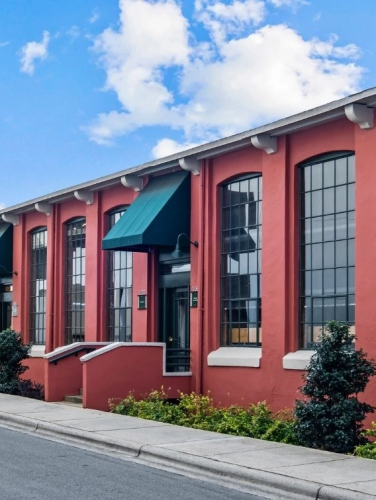
Atherton Cotton Mills
(ca. 1893)
Atherton Cotton Mills was the first cotton mill built and operated by one of Charlotte’s leading late nineteenth century industrialists, Daniel Augustus Tompkins.
2108 South Blvd, Charlotte, NC 28203
As the first industrial plant in the industrial district of Dilworth, Charlotte’s initial streetcar suburb, the Atherton Cotton Mills evidences the city’s emergence as a major textile manufacturing center in the late 1800s and early 1900s. Atherton was one of only three spinning mills owned and operated by Daniel Augustus Tompkins (1851-1914), a New South industrialist of profound importance in the economic development of Charlotte and its environs, through his namesake D. A. Tompkins Company.
Property Quick Links
The son of an Edgefield, South Carolina planter, Tompkins studied engineering at Rensselaer Polytechnic Institute in Troy, New York. He later leveraged his work experience as a chief machinist for Pennsylvania’s Bethlehem Iron Works to secure a franchise from the Westinghouse Machine Company to sell and install steam engines and other industrial machinery. He arrived in Charlotte in March 1883 having chosen the city as the location for his company because of its excellent railroad facilities. Tompkins and business partners Edward Arthur Smith (1862-1933) and Robert M. Miller, Jr. (1856-1925) formed the D. A. Tompkins Company in March 1883 to construct cotton and cotton seed oil mills throughout the South, including Charlotte's second, third, and fourth cotton mills (the Alpha, Ada, and Victor). In 1889, the three men launched the Charlotte Supply Company as a local supplier for the machinery and equipment needed to operate the city’s new mills. By 1906, the D. A. Tompkins Company had built more than 100 cotton mills and 250 cotton seed oil mills.
In July 1892, Tompkins, Smith, and Miller filed incorporation papers for "The Atherton Mills," Charlotte’s sixth cotton mill. Construction of the Atherton was completed four months later. The steam-powered mill, which drew its water from the old Summit Hill Gold Mine, was one of several new textile factories taking shape around the city at that time. Within three years, Atherton doubled its number of operating spindles to 10,000 and employed some 300 operatives, many of whom lived in an adjacent mill village that included fifty one-story frame houses and the Atherton Lyceum, a school that also housed a general store, town hall, and Sunday School classroom. Meanwhile, Tompkins also purchased and re-established the nearly defunct Charlotte Daily Observer as the Charlotte Observer in 1892, wrote books about the design and operation of cotton mills (notably Cotton Mill: Commercial Features (1899)), and helped develop textile college programs that later became part of N.C. State and Clemson Universities.
In 1922, a group of Gaston County textile plant operators headed by John C. Rankin and S.M. Robinson purchased the Atherton Mills, reorganizing it as Atherton Mills, Inc., but lost ownership of the South Boulevard plant in 1933 due to foreclosure. From 1937 to the early 1960s, the factory was owned and operated by J. Schoenith Company, Inc., a manufacturer of candy, baked goods, and peanut products. In recent years, various adaptive reuses of the campus have included wholesaling and textile-related manufacturing companies, restaurants, commercial ventures, and condominiums.

